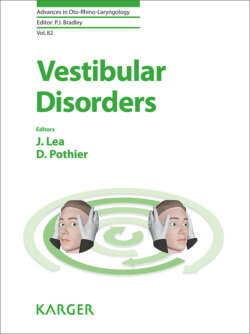Vestibular Disorders

Реклама. ООО «ЛитРес», ИНН: 7719571260.
Оглавление
Группа авторов. Vestibular Disorders
Advances in Oto-Rhino-Laryngology
Vestibular Disorders
Contents
Dedication
Preface
Assessment of the Vestibular System: History and Physical Examination
Abstract
The History: What to Ask
The Examination: What to Look For
General Inspection
Oculomotor Examination: Spontaneous and Gaze-Evoked Nystagmus
Positional Testing
“Pseudo BPV”
Head-Shaking Nystagmus
The Head Impulse
Testing Saccades and Pursuit
Visual Cancellation of the Vestibulo-Ocular Reflex
Stance and Gait
Postural Blood Pressure, Pulse, and Auscultation
Differential Diagnosis
References
Imaging of Temporal Bone
Abstract
Introduction
Computed Tomography
Cone-Beam CT
Magnetic Resonance Imaging
Future Development. Novel Contrast Agents
Targeted Contrast Agents
Microtomography
High-Resolution CARS
Conclusions
References
Videonystagmography and Posturography
Abstract
Introduction
Videonystagmography
Monothermal Calorics
Air versus Water Calorics
Posturography
Considerations for Future Research
Technological Innovations
References
Vestibular Testing-Rotary Chair and Dynamic Visual Acuity Tests
Abstract
Rotary Chair
Overview
Advances
Dynamic Visual Acuity
Overview
Advances
References
Otolith Function Testing
Abstract
Vestibular Evoked Myogenic Potentials
Methods of Recording and Eliciting VEMPs
VEMP Stimuli
VEMP Outcome Measures
Subjective Visual Vertical/Horizontal Testing
Clinical Application of Otolith Function Testing
Vestibular Neuritis
Vestibular Schwannoma
Episodic Vertigo (Ménière’s Disease and Vestibular Migraine)
Benign Positional Vertigo
Third Mobile Window Disorders
Conclusion
References
Video Head Impulse Testing
Abstract
The Bedside Head Impulse Test
The Video Head Impulse Test
vHIT during an Acute Vestibular Syndrome
vHIT after an Acute Vestibular Syndrome
vHIT for Recurrent Vertigo Attacks
vHIT for Testing Imbalance
vHIT Potential Practical Pitfalls
vHIT and Caloric Testing
vHIT and VEMPs
Future Directions in vHIT Testing
References
Benign Paroxysmal Positional Vertigo
Abstract
Introduction
Etiology
Evaluation
Posterior
Horizontal
Superior
Treatment
Posterior
Horizontal
Superior
References
Meniere’s Disease
Abstract
Introduction
The Pathologic Mechanism
Diagnosis
Supportive Investigations
The Natural History
Stages
Treatment. Management of Acute Attacks of Vertigo
Long-Term Management
Major Surgical Management
Conclusions
References
Vestibular Neuritis: Recent Advances in Etiology, Diagnostic Evaluation, and Treatment
Abstract
Etiology
Evaluation
Acute Vertigo as a Predictor of Vestibular Schwannoma
Treatment
References
Perilymphatic Fistulas and Superior Semi-Circular Canal Dehiscence Syndrome
Abstract
Introduction
Perilymphatic Fistula
Superior Semi-Circular Canal Dehiscence Syndrome
Summary
References
Aminoglycoside Vestibulotoxicity
Abstract
Aminoglycoside Vestibulotoxicity
In vitro Aminoglycoside Activity, Therapeutic Use, Toxicities and Genetics: A Brief Overview
Vestibulotoxicity
Risk Factors for Vestibulotoxicity
Single Daily Dosing (SDD) versus Multiple Daily Dosing (MDD): Predictions for Vestibulotoxicity
Observations on Aminoglycoside Vestibulotoxicity
Oscillopsia and Disequilibrium are Important Presenting Symptoms, Not Vertigo or Hearing Loss
Renal Dysfunction during Treatment is Not a Necessary Prerequisite for Vestibulotoxicity
Vestibulotoxicity can Occur in a Delayed Fashion Following Aminoglycoside Discontinuation
A Spectrum of Vestibular Dysfunction can be Found in Affected Patients
Is There a Difference in Vestibulotoxicity in Different Dosing Regimes?: MDD versus SDD Administration from the University Health Network Experience
Effective Aminoglycoside Monitoring
Other Considerations. Intended Vestibulotoxicity for Ménière’s Disease
Ototopical Toxicity
Medicolegal Ramifications
Acknowledgements
References
Post-Traumatic Dizziness: Clinical and Medicolegal Aspects
Abstract
Introduction
Mode of Injury
Site of Lesion
Unique Conditions for Consideration
Neuroimaging in TBI
Role of Litigation
Determining Causation
Your Role as a Medical Expert in the Legal System
Conclusions
References
Migraine Associated Vertigo
Abstract
Introduction
Pathophysiology of MAV
Common Historical Features of MAV
Epidemiology and Risk Factors of MAV
Physical Examination in MAV
Paraclinical Testing for MAV
Differential Diagnosis of MAV
Management of MAV
Prognosis of MAV
References
An Overview of Central Vertigo Disorders
Abstract
Introduction. Anatomy of Central Vestibular Signals
Brainstem Vestibular Pathways
Clinical Disorders of the Central Vestibular System
Medulla
Pons
Midbrain
Therapy for Central Nystagmus Causes of Vertigo
References
Special Considerations for the Pediatric Patient
Abstract
Introduction
Maturation of the Vestibular System
Development of Motor Control
Clinical Evaluation. History
Examination of the Child
Evaluation of Vestibular End Organ Function. General Considerations
Tests of Otolithic Function
Behavioral Assessment of Vestibular Function
Vestibular Disorders in Children
Benign Paroxysmal Vertigo of Childhood
MEE/Otitis Media with Effusion
Mental Health Symptoms
Vestibular Impairment Related to SNHL
Ototoxicity
Summary
References
The Aging Vestibular System: Dizziness and Imbalance in the Elderly
Abstract
Introduction
Aging of Vestibular Structures
Aging of Vestibular Functions
Vertigo, Dizziness, and Imbalance in Advanced Age: Common Causes
Benign Paroxysmal Positional Vertigo
Bilateral Vestibular Hypofunction
Central Vertigo
Gait Instability and Falls
Conclusion
References
Systemic Disease Considerations in the Management of the Dizzy Patient
Abstract
Introduction
Auto-Immune Disease
Cardiac
Neurally Mediated Reflex Syndromes
Orthostatic and Other Dysautonomic Syndromes
Cardiac Syncopal Syndromes
Metabolic
Pregnancy
Neurological
Genetic
Medication
Gastrointestinal
Orthopedic
Hematological
Infections
Respiratory
Peripheral Neuropathies
Vitamin Deficiencies
Paraneoplastic Syndrome
Poisoning
Conclusion
References
Advances in Vestibular Rehabilitation
Abstract
Introduction
Unilateral Vestibular Hypofunction
Balance and Gait Training
Gaze Stabilization
Timing of Intervention
Visually Induced Dizziness
Bilateral Vestibular Hypofunction
Biofeedback Training
Gaze Stabilization
Vestibular Prosthesis
Conclusion
References
Psychiatric Considerations in the Management of Dizzy Patients
Abstract
Introduction
Acute Vestibular Syndrome – Psychiatric Causes and Comorbidity
EVS – Psychiatric Causes and Comorbidity
CVS – Psychiatric Causes and Comorbidity
CVS – PPPD
Strategies to Identify Functional and Psychiatric Morbidity in Dizzy Patients
Treatment of Psychiatric Vestibular Disorders and PPPD
Conclusions
References
Author Index
Subject Index
Отрывок из книги
Vol. 82
Series Editor
.....
75Zou J, Pyykko I, Counter SA, Klason T, Bretlau P, Bjelke B: In vivo observation of dynamic perilymph formation using 4.7 T MRI with gadolinium as a tracer. Acta Otolaryngol 2003;123:910–915.
76Zou J, Zhang W, Poe D, Zhang Y, Ramadan UA, Pyykko I: Differential passage of gadolinium through the mouse inner ear barriers evaluated with 4.7T MRI. Hear Res 2010;259:36–43.
.....